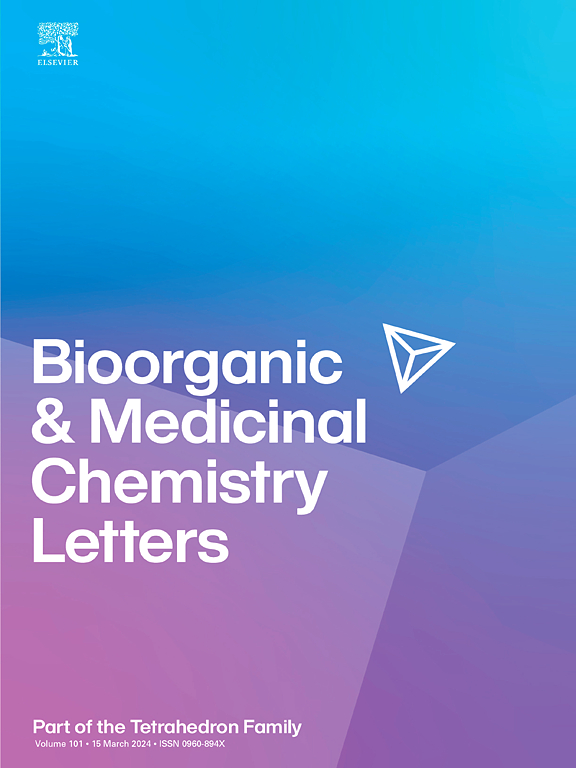Tyrosine and proline conjugated trolox, hydroxy-cinnnamic acid and diclofenac hybrids as strong hypolipidemic and anti-inflammatory agents.
IF 2.5
4区 医学
Q3 CHEMISTRY, MEDICINAL
引用次数: 0
Abstract
Oxidative stress induces the signaling of inflammatory and apoptotic pathways leading to the progression of degenerative disorders, whilst lipid increase and oxidation is an important factor for their development and propagation. L-tyrosine and L-proline amino acids and their derivatives have shown to be implicated in several of these aspects in a positive manner. In this prospect, methyl esters of these amino acids, amidated with the antioxidants trolox and (E)-3-(3,5-di-tert-butyl-4-hydroxyphenyl)acrylic acid (hydroxylated cinnamic acid compound), as well as the classical NSAID diclofenac, were prepared and evaluated as antioxidant, anti-inflammatory and anti-hyperlipidemic agents. Almost all compounds presented high or moderate 2,2-diphenyl-1-picrylhydrazyl (DPPH) radical scavenging and lipid peroxidation inhibitory activity, reaching up to 12 fold (in the lipid peroxidation inhibition) that of the parent antioxidant acids, such as trolox, whilst the insertion of the tyrosine moiety seemed to offer additional antioxidant potency, especially in the case of the NSAID derivative (compound 3). The majority of them displayed significant in vivo acute inflammation reduction (decrease of paw oedema, induced by carrageenan, 33–78 % at 150 μmol/kg) ability. The most active trolox-proline hybrid (compound 4) exhibited more than two fold increased inhibition in comparison to the well-established NSAIDs ibuprofen and diclofenac. They were also moderate inhibitors of soybean lipoxygenase, however active, in several cases, compared to their parent acid molecules. The most profound activity of the compounds was the reduction of the plasma lipidemic indices (Triton-induced hyperlipidemia in rats). Compound 5 was the most potent, with decrease in triglycerides, total cholesterol and low density lipoprotein, by 56 %, 87 %, and 72 %, respectively at 150 μmol/kg (i.p.), slightly better than that of simvastatin. Thus, the insertion of proline and tyrosine moieties seem to improve the anti-inflammatory activity of parent acids and NSAIDs, resulting in compounds with two or more pharmacological features (including hypolipidemic activity), which might be beneficial in cases characterized by inflammatory, oxidative, hyperlipidemic and degenerative conditions.

酪氨酸和脯氨酸结合的trolox,羟基肉桂酸和双氯芬酸混合物作为强降血脂和抗炎剂。
氧化应激诱导炎症和凋亡信号通路,导致退行性疾病的进展,而脂质增加和氧化是其发展和传播的重要因素。l -酪氨酸和l -脯氨酸氨基酸及其衍生物已被证明在这些方面有积极的影响。在本研究中,制备了这些氨基酸的甲酯,并与抗氧化剂trolox和(E)-3-(3,5-二叔丁基-4-羟基苯基)丙烯酸(羟基化肉桂酸化合物)以及经典的非甾体抗炎药双氯芬酸进行了修饰,并对其作为抗氧化、抗炎和抗高脂血症药物进行了评价。几乎所有化合物都表现出高或中等的2,2-二苯基-1-苦酰肼(DPPH)自由基清除和脂质过氧化抑制活性,达到母体抗氧化酸(在脂质过氧化抑制中)的12倍,如trolox,而酪氨酸片段的插入似乎提供了额外的抗氧化能力。特别是非甾体抗炎药衍生物(化合物3)。它们中的大多数在体内表现出显著的急性炎症减轻能力(卡拉胶诱导的足跖水肿减轻,150 μmol/kg, 33-78 %)。最活跃的trolox-脯氨酸混合物(化合物4)表现出比公认的非甾体抗炎药布洛芬和双氯芬酸增加两倍以上的抑制作用。与它们的母体酸分子相比,它们也是大豆脂氧合酶的中度抑制剂,但在某些情况下是活跃的。化合物最显著的活性是降低血浆血脂指数(triton诱导的大鼠高脂血症)。化合物5效果最好,在150 μmol/kg (i.p)时,甘油三酯、总胆固醇和低密度脂蛋白分别降低56 %、87 %和72 %,略优于辛伐他汀。因此,脯氨酸和酪氨酸片段的插入似乎可以提高母体酸和非甾体抗炎药的抗炎活性,从而产生具有两种或多种药理特征(包括降血脂活性)的化合物,这可能对炎症、氧化、高脂血症和退行性疾病的病例有益。
本文章由计算机程序翻译,如有差异,请以英文原文为准。
求助全文
约1分钟内获得全文
求助全文
来源期刊
CiteScore
5.70
自引率
3.70%
发文量
463
审稿时长
27 days
期刊介绍:
Bioorganic & Medicinal Chemistry Letters presents preliminary experimental or theoretical research results of outstanding significance and timeliness on all aspects of science at the interface of chemistry and biology and on major advances in drug design and development. The journal publishes articles in the form of communications reporting experimental or theoretical results of special interest, and strives to provide maximum dissemination to a large, international audience.

 求助内容:
求助内容: 应助结果提醒方式:
应助结果提醒方式:


